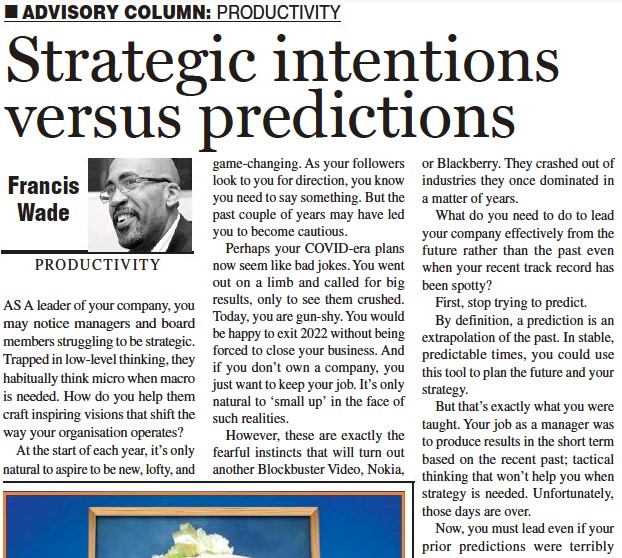As a leader of your company, you may notice managers and board members struggling to be strategic. Trapped in low-level thinking, they habitually think micro when macro is needed. How do you help them craft inspiring visions that shift the way your organization operates?
At the start of each year, it’s only natural to aspire to be new, lofty and game-changing. As your followers look to you for direction, you know you need to say “something”. But the past couple of years may have led you to become cautious.
Perhaps your COVID-era plans now seem like bad jokes. You went out on a limb and called for big results, only to see them crushed. Today, you are gun-shy. You would be happy to exit 2022 without being forced to close your business. And if you don’t own a company, you just want to keep your job. It’s only natural to “small up” in the face of such realities.
However, these are exactly the fearful instincts that will turn out another Blockbuster Video, Nokia or Blackberry. They crashed out of industries they once dominated in a matter of years.
What do you need to do to lead your company effectively from the future rather than the past, even when your recent track record has been spotty?
- Stop Trying to Predict
By definition, a prediction is an extrapolation of the past. In stable, predictable times, you could use this tool to plan the future and your strategy.
But that’s exactly what you were taught. Your job as a manager was to produce results in the short term based on the recent past; tactical thinking that won’t help you when strategy is needed. Unfortunately, those days are over.
Now you must lead even if your prior predictions were terribly wrong, and you looked bad, foolish or stupid. Your natural tendency may be to think in shorter time-frames in order to make fewer mistakes.
As a leader crafting a fresh future, you need to stop predicting. Coming up with a new vision was never about making predictions and never will be.
- Replace Predictions with Intentions
The best strategic planning is about crafting intentions rather than predictions. They are always born in the future. Imagine a six-year-old saying “I want to be a doctor!” Good parents don’t scoff at such intentions, even though they aren’t based on facts.
However, the same child, if asked to predict, would probably say, “I want to keep playing with my toys!“
As an adult, you should gather all the facts you can muster. But at the end of the fact-finding, you must still craft an intention that is merely informed by the data, not limited by it. In other words, there will always be a risk when creating intentions which are meant to be ground-breaking, or transformational.
But what if your last few intentions produced nothing at all? What should you do then to be an effective leader?
- Close Out Prior Intentions and Craft New Ones
Even if recent efforts have failed, your organization still needs you to lead from the future. However, you could be hampered by your track record.
If so, consider bringing previous intentions to closure so your followers can hear a new one.
This may sound challenging or painful, but it isn’t. Simply take a critical mass of employees along a journey to explore the facts regarding the last failed intention. Doing so will lay the ground for whatever is coming next.
But be clear about your role. As a leader, you are the limiting factor. When you fail to create an effective, inspiring vision, don’t expect your managers to take up the slack. Their skills are limited.
However, as the leader, you have no excuse.
Your job is to get up in front of your staff each and every year with a vision of breakthrough results. When you shy away from doing so, you are dooming your organization. Don’t be surprised when it returns the favor with mediocre performance.
Seems impossible? If you can’t manage, get expert help. As the new year starts, your company needs you to be at your best, on top of your game. Call your personal development the recurring price to be paid by anyone who is in your position.
Also, you may need to train your managers and board members to think from the future, and be inspiring. At the very least, they should understand what a strategic vision is meant to do, so they don’t become obstacles.
But the buck stops with you. It’s your job to demonstrate that everyday management may be about predicting, but strategic leadership is about crafting inspiring intentions.
In summary, your people want to be led. As the occupant of an executive position, do your job.

